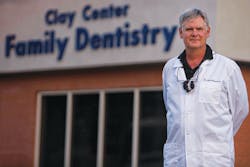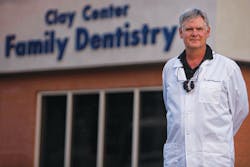Preparing for retirement by investing in technology
Interview with Rick Hammel, DDS, and Nancy Hammel
By Chris Salierno, DDS Chief Editor, Dental Economics
The average retirement ageof dentists has increased in the past 10 years. According to the ADA's Health Policy Institute, the average age for retirement for dentists in 2011 was 68.3, a notable increase from 2001, when dentists were hanging up their handpieces at 64.8 years old.1 In the US over the past two decades, interest in dentistry has shown a steady period of growth.2 While some dentists are retiring, many graduates are making plans for their new careers. These young dentists are seeking offices with technology that matches their experiences from dental school. When you only learn digital charting and digital radiographs, it's jarring to visit an office that is still working in analog.
With these statistics in mind, I wanted to see how retiring dentists are investing in technology as a transition strategy during their final years of practice. Digital practice management software, digital radiographs, cone beam 3-D imaging, and CAD/CAM certainly bring fresh revenue streams and can renew a dentist's energy for practice. However, I also believe adding these innovations in the years leading to retirement is a sound exit strategy. I spoke with Rick Hammel, DDS, and his wife and practice manager, Nancy HAMMEL, from Clay Center, Kansas, about their experience doing just that.
DE: Dr. Hammel, how did you prepare your practice for sale before retirement?
Dr. Hammel: Our practice was in a very rural area. We had built a new building in 2000, and our patients were impressed with our innovative office and technology. We started to develop a reputation because we were different than other practices. That's a big selling point-but you must start early so the news spreads about your technology and grows your patient base along the way. New technologies are not simply shiny toys-they are meaningful tools to treat a variety of patients and perform additional procedures. They helped me become "super" productive, and that automatically increases the value of the practice. In short, use technology for better patient care, and word gets around.
Nancy: Besides the clinical aspects, practices are businesses too. You can have all the technology, but you must also have good money management and a practical business plan. The strategy of selling the practice needs to be thought out many years in advance. For example, you have to establish a budget. New technologies are amazing and evolving to make dentistry faster, better, and easier, but once dentists start adding tech, they can become "addicted." Then they always want more and lose sight of the bottom line. So prepare a budget that can accommodate for the addition of different components over time. Also, make sure you will actually use the equipment you buy. In our case, digital imaging was a part of our practice that was used every day, all day. For example, our DEXIS digital imaging system helped us to save money that we would have wasted on developing chemicals and film. The images were immediate, high quality, and-because of their digital nature-we could then enlarge, zoom in, and display them on a large monitor for better patient education. This technology was beneficial for us and for our patients, and it will continue to be a great advantage for the next owner of the practice.
DE: What were some of the challenges of selling the practice?
Nancy: We lived in a rural area, so that was a strike against us as far as finding an associate. Many want to start in a big city, but we did talk to a young man who eventually bought our practice. He saw my husband as a mentor from whom he could learn a great deal. Also, he recognized that he was coming into an efficient, productive practice with stable, well-managed employees and a low turnover rate. That really decreased the likelihood that he was going to run away! At the beginning, we told him that honestly, we wanted an associate, and at the time, we did not expect him to be a buyer.
DE: So how is retirement?
Dr. Hammel: Well, I had sold my practice and basically retired while finishing some orthodontic cases one Monday a month. Now, I work at a practice in Kansas City for a dentist who is the same age as I am. He has a big practice with 25 employees and two associates. Both associates left (one for maternity leave), and I stepped in to help out. This dentist's goal is to retain ownership and management of his dental practice and only work a half-day a week. He wants to attract quality associates, so he offers a well-run practice with some really great technologies. The practice is a retirement investment and a continuing revenue stream for him.
Those who are invested in dentistry, like Dr. Hammel, sometimes have a difficult time just walking away from a lifetime chairside. But you don't have to buy all the great technology and leave. Over time, investing in technology and actually using it is one way to keep the momentum going and show patients and potential buyers that you care. Dr. Hammel calls his story a "wake-up call." He recommends creating a technologically fulfilled office, enjoy providing the best dental care possible during your working years, and, when the time comes, you will be able to attract the best dentists to care for your legacy.
ACTIVE RETIREMENT: Dr. Rick Hammel and Nancy Hammel on a medical aid trip to Belize.
References
1. Vujicic M, Munson B, Nasseh K. Research Brief: Despite Economic Recovery, Dentist Earnings Remain Flat. Online document. American Dental Association, Health Policy Institute. October 2013. http://www.ada.org/~/media/ADA/Science%20and%20Research/HPI/Files/HPIBrief_1013_4.ashx. Accessed June 8, 2015.
2. American Dental Education Association. U. S. Dental School Applicants and Enrollees, 2010 Entering Class. Online document. http://www.adea.org/publications/library/ADEAsurveysreports/Pages/ADEA SurveyofUSDental SchoolApplicants andEnrollees2010 2011.aspx. Accessed June 8, 2015.




